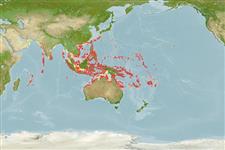Actinopterygii (ray-finned fishes) >
Perciformes (Perch-likes) >
Haemulidae (Grunts) > Plectorhinchinae
Etymology: Plectorhinchus: Greek, plektos = plaited + Greek, rhyngchos = snout (Ref. 45335). More on author: Lacepède.
Environment / Climate / Range
Ecology
Marine; brackish; reef-associated; depth range 1 - 30 m (Ref. 9710). Tropical, preferred ?; 31°N - 23°S, 57°E - 173°W
Indian Ocean: Maldives (Ref. 11303) and Cocos Islands (Ref. 9399). Western Pacific: Sumatra to Fiji (Ref. 9710) and New Caledonia, north to Ryukyu Islands, south to Rowley Shoals.
Length at first maturity / Size / Weight / Age
Maturity: Lm ?, range 40 - ? cm
Max length : 72.0 cm TL male/unsexed; (Ref. 9710); common length : 60.0 cm SL male/unsexed; (Ref. 37816); max. published weight: 7.0 kg (Ref. 9710)
Inhabits coral-rich areas of clear lagoon and seaward reefs. Adults are solitary, near and under ledges or caves by day. Juveniles are found among corals (Ref. 9710). Feeds on crustaceans, mollusks, and fishes at night. Juveniles are used in the aquarium industry (Ref. 9137). Small juveniles may mimic a toxic flatworm (Ref. 9710).
Life cycle and mating behavior
Maturity | Reproduction | Spawning | Eggs | Fecundity | Larvae
Oviparous, distinct pairing during breeding (Ref. 205).
Myers, R.F., 1991. Micronesian reef fishes. Second Ed. Coral Graphics, Barrigada, Guam. 298 p. (Ref. 1602)
IUCN Red List Status (Ref. 115185)
CITES (Ref. 94142)
Not Evaluated
Threat to humans
Harmless
Human uses
Fisheries: minor commercial; aquarium: commercial
More information
ReferencesAquacultureAquaculture profileStrainsGeneticsAllele frequenciesHeritabilityDiseasesProcessingMass conversion
Tools
Special reports
Download XML
Internet sources
Estimates of some properties based on models
Phylogenetic diversity index (Ref.
82805): PD
50 = 0.5000 [Uniqueness, from 0.5 = low to 2.0 = high].
Bayesian length-weight: a=0.01778 (0.01087 - 0.02908), b=2.98 (2.84 - 3.12), in cm Total Length, based on LWR estimates for this species & (Sub)family-body (Ref.
93245).
Trophic Level (Ref.
69278): 3.8 ±0.60 se; Based on food items.
Resilience (Ref.
69278): Low, minimum population doubling time 4.5 - 14 years (Preliminary K or Fecundity.).
Vulnerability (Ref.
59153): Moderate to high vulnerability (54 of 100) .
